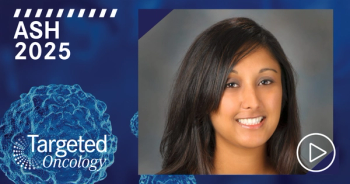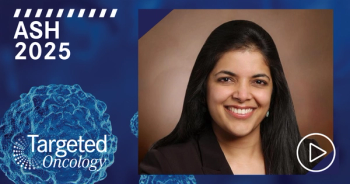
CD22-Directed CAR Therapy Achieves High CR Rate in R/R CD22+ Hematologic Malignancies
A novel CD22-targeted/4-1BB product achieved a high complete response rate in patients with relapse or refractory CDD22-positive cancers.
Chimeric antigen receptor (CAR) T-cell therapy with a novel CD22-targeted/4-1BB product led to a high complete remission (CR) rate in children and young adults with relapsed or refractory CDD22-positive malignancies, according to findings from a phase 1 study.
Earlier findings from the phase 1 study showed that CD22 CAR T cells can be an effective salvage regimen for patients who fail CD19-targeted therapy. Updated results of the study were published in the Journal of Clinical Oncology.
“In this expanded experience with the first, to our knowledge, successful CAR to target an alternative antigen on acute lymphoblastic leukemia (ALL), we establish CD22 CAR T cells as an effective salvage therapy for patients who have experienced relapse after or are refractory to CD19-targeted therapies,” the investigators, led by Nirali N. Shah, MD, MHSc, of the Center for Cancer Research, National Cancer Institute, wrote in their report.
The phase 1 dose-escalation study explored the use of CD22 CAR T cells to treat patients with relapsed/refractory CD22-positive B-cell malignancies.
Among patients who had previously received CAR T cell therapy, <5% circulating CAR T cells was required at baseline. Patients with active central nervous system (CNS) disease were allowed on the trial in a separate cohort.
Patients were treated at one of 3 dose levels: 3 x 105/kg, 1 x 106/kg, or 3 x 106/kg. Conditioning therapy included 25 mg/m2/day of fludarabine for days 2 through 4 prior to T-cell therapy infusion and 900 mg/m2 of cyclophosphamide on day 2 ahead of infusion. At dose level 1 and 2, CD4/CD8 T-cell selection (TCS) was also incorporated to enhance CAR T-cell manufacturing feasibility and reduce variability between patients. TCS led to heightened inflammatory responses at dose level 2, so dose level 1 with TCS was chosen as the escalation dose.
The primary end points of the study were safety, toxicity, and manufacturing feasibility. Secondary end points included efficacy, CAR T-cell persistence, evaluation of reinfusion strategies, and cytokine profiling.
A total of 64 patients were enrolled in the study with 58 evaluable for the safety assessment. The majority of patients had ALL, but one patient had diffuse large B-cell lymphoma and another had chronic myelogenous leukemia with ALL blast crisis. The median age for all patients across all dose levels was 17.5 years (range, 4.4-30.6 years). More than half of the patients (56.9%) had complete or partial CD19 negativity. Eleven patients (19%) had extramedullary disease and 1 patients (1.7%) had isolated CNS disease.
Prior treatment consisted of CD19-targeted therapy in 87.9%, CD19-directed CAR T-cell therapy in 62.0%, hematopoietic stem cell transplantation (HSCT) in 67.2%, blinatumomab (Blincyto) in 39.7%, inotuzumab ozogamicin (Besponsa) in 24.1%, and prior CD22 CAR T-cell exposure in 8.6%.
Fifty-seven patients who received T-cell infusion were evaluable for efficacy assessment. Of these patients, 70.2% achieved a CR and 87.5% of these patients also had minimal residual disease (MRD) negativity status by flow cytometry. Among the patients with ALL alone, the rate of CR was 72.7% and the MRD-negative rate was 63.6%.
The investigators noted that responses were not affected by prior CD19-targeted therapy or prior HSCT. Also, 2 CD19-positive patients who did not have a prior response to CD19-targeted therapy achieved a CR and MRD negativity, meaning that nonresponse did not preclude them from responding to CD22-targeted therapy.
Of note, patients who had previously received inotuzumab ozogamicin or a CD22-directed CAR T-cell therapy were more likely to have residual CD22 disease at restaging, have decreased MRD negativity and CR, and have shorter remission times than those who did not receive prior CD22-targeted therapy.
Thirteen patients went on to receive HSCT, which was the first HSCT for 10 of these participants, and the median time to HSCT was 72 days (range, 49-126 days). Six patients relapsed after HSCT though.
After a median potential follow-up of 2 years, the median overall survival was 13.4 months (95% CI, 7.7-20.3), and the median relapse-free survival for patients in CR was 6.0 months (95% CI, 4.1-6.5). The median event-free survival was 3.2 months (95% CI, 1.4-5.5). Three-fourths of the patients relapsed, most of whom had CD22-negative or diminished disease.
As of data cutoff, 21 patients were still alive, 11 were still in remission. One patient has had an ongoing CR for at least 3.5 years following CAR T-cell therapy infusion and has not received any interval therapy.
CAR T-cell manufacturing was completed successfully for 63 of 64 participants. CD4/CD8 TCS helped to salvage apheresis material and improved transduction efficiency, fold expansion, and CD3 consistency and recovery.
In terms of toxicity, cytokine release syndrome (CRS) was observed in 86.2% of patients, 90% of which was grade 1 or 2 in severity. The average time to CRS was 7 days following infusion (range, 3-16). Two grade 5 CRS events occurred in patients being treated with dose level 2. This led to the investigators using tocilizumab (Actemra) and/or corticosteroids earlier on in patients with signs of pulmonary toxicities. No further grade 5 events were observed after this modification.
Neurotoxicity was seen in 32.8% of patients, most of which was grade 1 or 2 in severity, except for 1 patient treated at dose level 1 with TCS who developed grade 4 intracranial hemorrhage.
Further, 24.1% of patients developed disseminated intravascular coagulation, 15.5% developed symptomatic coagulopathy, 32.7% had hemophagocytic lymphohistiocytosis (HLH), and capillary leak syndrome and atypical hemolytic uremic syndrome were each seen in 5.2% of patients. Ocular manifestations were reported in 12 patients, but no cases of sinusoidal obstructive syndrome were reported.
The incidence of HLH/macrophage activation syndrome (MAS)–like toxicities was higher with CD4/CD8 TCS, and all cases of HLH/MAS were seen in patients who experienced CRS. Fourteen patients required treatment for HLH/MAS due to worsening laboratory values or clinical symptoms, but the cases resolved without any apparent impact on response or CAR T-cell expansion.
Peak CAR expansion occurred 14 to 21 days after infusion and the median percentage of CAR-positive T cells at peak expansion was 77%. The number of absolute CAR T cells tended to be higher in patients who underwent TCS.
“These results strongly support further development of CD22 CAR T cells in a pivotal phase II trial and provide a foundation for the first combinations of targeted immunotherapy using clinically validated CAR constructs with the potential to improve upon response and remission durability after targeted immunotherapy for B-cell malignancies,” Shah et al concluded.
Reference:
Shah NN, Highfill SL, Shalabi H, et al. CD4/CD8 T-Cell Selection Affects Chimeric Antigen Receptor (CAR) T-Cell Potency and Toxicity: Updated Results From a Phase I Anti-CD22 CAR T-Cell Trial. J Clin Oncol. Published online April 14, 2020. doi:10.1200/JCO.19.03279









































